 Empowered Special #6 — Writer: Adam Warren; Art: Adam Warren and Brandon Graham
Empowered Special #6 — Writer: Adam Warren; Art: Adam Warren and Brandon Graham
I’ve made no secret of my fondness for Warren’s starcrossed, plucky heroine and her always-interesting supporting cast; throw in 24 pages of color Brandon Graham art in the middle (he and Warren are a match made in sf heaven; both have a knack for telling stories that blend technology, aliens, strong female characters, brainy plots and clever dialogue) and this moves to the top of the list, even in a week with a number of strong books.
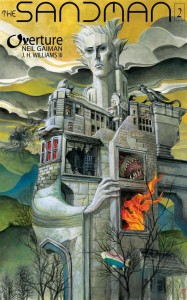 Sandman: Overture #2 (of 6) — Writer: Neil Gaiman; Art: J.H. Williams III
Sandman: Overture #2 (of 6) — Writer: Neil Gaiman; Art: J.H. Williams III
There’s a lot going on in this comic, and it’s very good, although I’m not sure it’s for new readers — Sandman has a rich, and potentially confusing, mythology. On the other hand, Gaiman is good at making everything fascinating, even if a reader isn’t sure who this guy Dream is, or why he has lots of different versions of himself, or why they’re worried about something called a “vortex.” Williams III makes it all very pretty, with his imaginative layouts and ability to fill up the page with details (having worked with Alan Moore on Promethea, he’s had experience working with top-level writers and complicated backstories). If anyone gets too confused… well, any comics fan worth the name should have copies of the Sandman trades on your bookshelves anyway, and if admiring this book makes you go out and get them, so much the better.
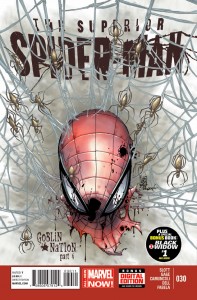 Superior Spider-Man #30 — Plot: Dan Slott; Script: Christos Gage; Pencils: Giuseppe Camuncoli; Inks: John Dell and Terry Pallot
Superior Spider-Man #30 — Plot: Dan Slott; Script: Christos Gage; Pencils: Giuseppe Camuncoli; Inks: John Dell and Terry Pallot
It’s probably not a spoiler to mention that, after the next issue of this book, it’s being replaced by the new Amazing Spider-Man #1 next month, right? You all knew that? Then you won’t be surprised that, in the midst of our sort-of hero facing a Green Goblin whose forces seem triumphant, that the last six pages of this comic feature a changing of the guard, and the costume, that should thrill longtime readers, and lead into what promises to be a slam-bang conclusion in two weeks (and just in time for the new movie, too — what are the odds…?) Oh — there’s a full reprint of the recent Black Widow #1 included, at no extra cost. That was a smart, well-done relaunch of that character, so maybe getting more readers to sample it this way will earn it some well-deserved new sales.
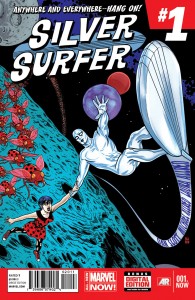 Silver Surfer #1 — Writer: Dan Slott; Art: Michael Allred
Silver Surfer #1 — Writer: Dan Slott; Art: Michael Allred
Well, this is a fun comic. No surprise — the Slott/Allred team’s version of the Surfer was featured in the Marvel Now! preview book a few months ago, and managed to look simultaneously sleek and modern, retro, and pleasantly tongue-in-cheek; this first issue explains where Norrin Radd’s current traveling companion came from, and sets up his quest for the next few issues. Allred’s attractively-minimalist version of the Surfer shows why he’s such an inspired choice to draw this character, and he provides a double-page-splash reveal of an enormous space colony that’s just amazing (his wife Laura, who’s the colorist on this book, does just as impressive a job on it). This is yet another in a line of Marvel titles — Hawkeye, Daredevil and She-Hulk, especially — that are just buzzing with energy, innovation and appealing storytelling right now, and should be on everyone’s buy list; don’t miss it and have to pay a premium to get it later.
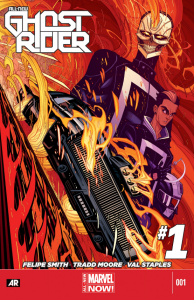 All-New Ghost Rider #1 — Writer: Felipe Smith; Art: Tradd Moore
All-New Ghost Rider #1 — Writer: Felipe Smith; Art: Tradd Moore
You can’t accuse this book of being the same old Ghost Rider — for one thing, it’s a new character wearing the flaming head, and for another his preferred mode of transportation is a flaming car (let the “hot-rod” jokes commence…). Not only that, but the creative team brings a heavy global/manga influence to the book: Smith, the writer, has Jamaican, Argentinian and American ancestry, and has written and drawn comics in Japan, a neat trick for a non-Japanese creator. Moore, an American probably best known as artist on the two Luther Strode series from Image, has also drawn a few Deadpool covers for the Marvel relaunch of that book, and had a couple of pages in the Harley Quinn #0 anthology issue; he has an angular, energetic style that’s an interesting blend of American and manga influences, and a good match for Smith’s script. I have no idea whether fans will go for this or not, but there’s nothing else quite like it on the stands right now.
 Iron Patriot #1 — Writer: Ales Kot; Art: Garry Brown
Iron Patriot #1 — Writer: Ales Kot; Art: Garry Brown
Kot’s getting quite a bit of attention right now for his Image comic Zero, a spy book with considerable style, and had a surprisingly-good debut as the writer on Marvel’s Secret Avengers #1 two weeks ago; Brown has been working as the artist on Brian Wood’s The Massive for the last year or so. This first issue shows potential, but it’s kind of slow going, because there’s a lot of setting up of the supporting cast and showing Rhodes’s relation to them, and explaining how he’s ending up in a red-white-and-blue suit of armor, and then finally getting him into the suit for a few pages and ending on a cliffhanger; it’s the kind of gradual buildup that works well in a trade, with more pages for a payoff right there, but may not be enough to bring readers back when they have to wait another issue (or more) here for it.
 Survive #1 (of 1) — Writer: Brian Michael Bendis; Art: Joe Quinones
Survive #1 (of 1) — Writer: Brian Michael Bendis; Art: Joe Quinones
This isn’t, really, a new book — it’s a continuation of Bendis’s run on the Ultimate Universe, particularly Ultimate Spider-Man, except that now Galactus has come and gone, Captain America and Thor are dead, the Ultimates have disbanded and everyone else is picking up the pieces. It pretty much leads directly into Ultimate Spider-Man #200 next month, so don’t miss it if you’re a fan of that title.
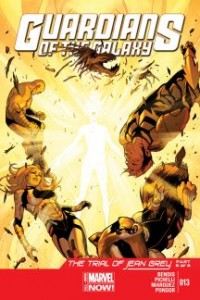 Guardians of the Galaxy #13 — Writer: Brian Michael Bendis; Art: Sara Pichelli and David Marquez
Guardians of the Galaxy #13 — Writer: Brian Michael Bendis; Art: Sara Pichelli and David Marquez
This completes the “Trial of Jean Grey” crossover with Uncanny X-Men, and focuses much more on the mutants than the Guardians; that’s OK, though, because Pichelli’s versions of them are cute (there’s a Kitty/Peter Quinn moment that’s downright adorable) and compelling, and there’s enough drama — various comings and goings of the characters, and relationship changes — to keep the soap-opera pot boiling. This book has an anniversary issue coming up next month, too: Guardians #100; I’m not even going to try to check the math on that, but the various volumes of the series make it probable, and it’ll make a nice giant-sized artifact just about in time for the movie (the cover preview in this issue shows, in addition to the current team, the ghostly images of the original, Starhawk-led future-Earth Guardians, so points for that…).
 Rocky and Bullwinkle #1 (of 4) — Writer: Mark Evanier; Art: Roger Langridge
Rocky and Bullwinkle #1 (of 4) — Writer: Mark Evanier; Art: Roger Langridge
I liked this comic a lot (and thought about putting it at the top), but you probably have to be a Baby Boomer to “get” Rocky and his dim-witted but good-hearted friend; I will say that Evanier, who’s about my age, has the voices down perfectly (I could even hear William Conrad in the narration boxes), and has a knack for puns, which makes him an inspired choice for this job. The remarkable Roger Langridge is a similarly-inspired choice for artist; he has a chameleonlike ease of adapting to any cartoony style that’s required (his Muppets looked absolutely Muppety, while his Popeye series came closer to the classic Elsie Segar strip than anyone since, maybe, Bud Sagendorf), and it serves him well here — a glance at the cover will confirm his skill. About the only thing publisher IDW didn’t do was throw in a text page for fans, with some history of the characters, although I suppose today anyone interested can just Google “Rocky and Bullwinkle,” or “Jay Ward,” and see why some of us have such fond memories of this crew; let’s hope the comic inspires newer generations to do just that.
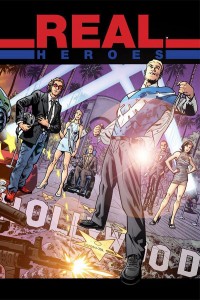 Real Heroes #1 — Writer/Artist: Brian Hitch
Real Heroes #1 — Writer/Artist: Brian Hitch
It’s not always a good idea when an artist adds scripting to his resume; after the first few pages here, I was thinking that it was a particularly bad idea, but fortunately Hitch threw in a twist that redeemed things enough for me to keep reading. It’s still kind of generic, but it’s readable (all those collaborations with Mark Millar probably helped), and the characters are undeniably good-looking and the superheroic action is undeniably well-drawn, so the 31 pages of art for your $3.99 seems like a reasonable enough deal.
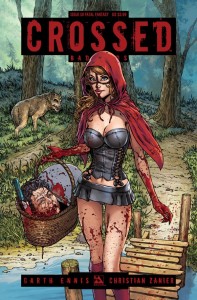 Crossed #50 — Writer: Garth Ennis; Art: Christian Zanier
Crossed #50 — Writer: Garth Ennis; Art: Christian Zanier
We’re getting down to the I-don’t-have-much-new-to-say territory here, but this is worth noting because of Ennis’s return to the title, and the fact that he’s writing about the origins of the “Crossed” plague. Not too much happens in this first installment, actually, but I’m more than willing to wait around for the inevitable apocalyptic behavior to begin in another issue or two.
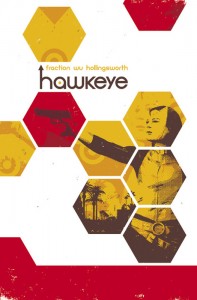 Hawkeye #18 — Writer: Matt Fraction; Art: Annie Wu
Hawkeye #18 — Writer: Matt Fraction; Art: Annie Wu
Kate continues to be a remarkably persistent but not-very-good LA detective, and at the end her story starts to hook up with Clint’s — a good thing, since he and his brother have been lying in pools of their own blood in New York for the last three freaking months. This has been a disjointed and sometimes-bumpy run, but I think it’s going to look really good when it’s all in order in a collection — and the fact that I care, and am hoping for some kind of redemptive and satisfying resolution, is a tribute to the way Fraction’s characters can hook a reader.
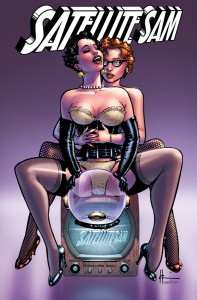 Satellite Sam #7 — Writer: Matt Fraction; Art: Howard Chaykin
Satellite Sam #7 — Writer: Matt Fraction; Art: Howard Chaykin
One of Fraction’s creator-owned titles from Image: Come for Howard Chaykin’s casually-expert evocation of the early-’50s broadcast-TV era, and stay for the way Fraction’s sometimes-cynical optimism, and Chaykin’s sometimes-optimistic cynicism, propel a large cast of flawed-but-fascinating people.
 Avengers #27 — Writer: Jonathan Hickman; Art: Salvador Larroca
Avengers #27 — Writer: Jonathan Hickman; Art: Salvador Larroca
New Avengers #16.Now — Writer: Jonathan Hickman; Art: Rags Morales
Hickman’s doing a lot of playing around with alternate Earths and realities here: the uber-plot involves Marvel Earth facing a series of “incursions” by other dimensions/universes, where either we destroy/absorb/eliminate them or they do it to us 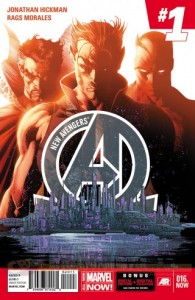 (it’s a slow-motion Crisis on Infinite Marvel Earths). This means he can have “our” Black Panther and Sub-Mariner watch a very JLA-inspired version of the Avengers in New Avengers , while in just Avengers there’s a darker-universe version of our team running around, courtesy of the A.I.M. scientists. This is starting to remind me of the ’90s-era books, which began to cover alternate universes promisingly with the Tom Defalco/John Buscema Black Knight/Sersi run, and then got obsessed and ended up with half-insect Wasp and teen Tony Stark and ohgodmakeitstop…. so, watch your step, guys.
(it’s a slow-motion Crisis on Infinite Marvel Earths). This means he can have “our” Black Panther and Sub-Mariner watch a very JLA-inspired version of the Avengers in New Avengers , while in just Avengers there’s a darker-universe version of our team running around, courtesy of the A.I.M. scientists. This is starting to remind me of the ’90s-era books, which began to cover alternate universes promisingly with the Tom Defalco/John Buscema Black Knight/Sersi run, and then got obsessed and ended up with half-insect Wasp and teen Tony Stark and ohgodmakeitstop…. so, watch your step, guys.
 Fatale #21 — Writer: Ed Brubaker; Art: Sean Phillips
Fatale #21 — Writer: Ed Brubaker; Art: Sean Phillips
Six of this book’s twenty-four pages feature the lead character standing around looking noirishly sexy and smoking; the American Cancer Society probably isn’t a fan. I am, though; this has been a knowing, effortlessly-professional exercise in hard-boiled detective fiction from the beginning, and it’s getting better as it nears the end of its run.
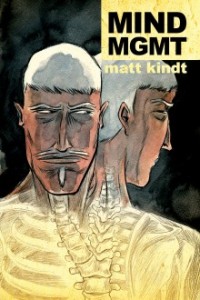 Mind Mgmt #20 — Writer/Artist: Matt Kindt
Mind Mgmt #20 — Writer/Artist: Matt Kindt
Man, is this a weird book. See that guy on the cover? He’s not the weirdest guy in the book. Kindt has a knack for this stuff, though, and his deceptively-casual art is hard to resist.
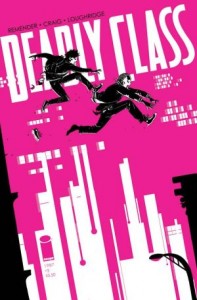 Deadly Class #3 — Writer: Rick Remender; Art: Wes Craig
Deadly Class #3 — Writer: Rick Remender; Art: Wes Craig
Two teenagers who are enrolled in a school for young assassins get their first assignment: kill a random homeless person. What happens next is hard to predict, in the best possible way; Remender’s become a very confident storyteller, and Craig’s clean, dynamic art (aided considerably by Lee Loughridge, the colorist) makes this easy to like.
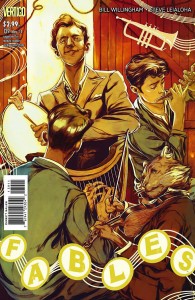 Fables #139 — Writer: Bill Willingham; Art: Steve Leialoha
Fables #139 — Writer: Bill Willingham; Art: Steve Leialoha
Eleven issues until the end of the run, and we’re told that the events that begin here will lead to the “final and inevitable destruction of Fabletown.” Since “Fabletown” is the village-in-exile of all our characters, and since there’s now no more reason for them to be “exiled,” I’m hoping that it will all end with most of them back in their own lands, reasonably happy.



